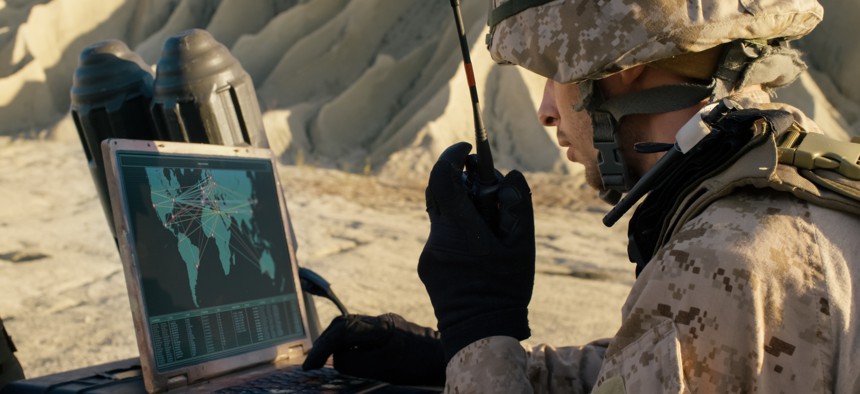sponsor content What's this?

The path to next generation cyberspace operations: How defense industry expertise empowers the joint cyber warfighting architecture vision
JCWA will be instrumental in helping our nation compete and win against adversaries, but scaled industry partnership is necessary for mission success.
Presented by
Peraton

The U.S. Cyber Command envisions the Joint Cyber Warfighting Architecture (JCWA) as the premier platform that will enable military forces to conduct full-spectrum cyberspace operations, both offensive and defensive, globally at scale.
In a combined joint forces operation, one comprising multiple military branches and allied nations operating across all domains, it can be difficult to realize this vision. Defense officials will need to leverage industry expertise to bring JCWA to fruition.
“The private sector has the right mix of talent and can make the investments needed to help discover and build those next generation cyber capabilities,” said Brian Russell, cyber and information warfare subject matter expert at Peraton.
Roadblocks to JCWA
The U.S. military branches have implemented a wide range of cyber solutions over the years. As they look to combine those resources, the Pentagon’s Office of the Director, Operational Test and Evaluation, has warned of “an ad-hoc alignment” that could lead to “fielding capabilities without demonstrating or understanding their contribution to JCWA operational effectiveness, suitability, or survivability.”
In joint all-domain command and control, “you have allies and partners operating on networks that might not be integrated. It can be challenging to understand that space and network topography,” Russell said.
Without said understanding, commanders may lack the situational awareness they need to make effective choices. “This is all about risk-informed decision making,” Russell said. “You can't defend everywhere. You have to prioritize in order to quickly shift a capability. It’s about cyber agility, the ability to understand very quickly and react very quickly.”
There are challenges around interoperability as well. “Allies and partners bring different network capabilities and even different procedures for authorizing employment of capabilities on those networks. It’s a huge integration challenge,” said Russell.
JCWA looks to give U.S. forces the insights they need to operate effectively in the cyber environment. To get there, government will need industry partners with a proven ability to deliver the infrastructure and data architecture needed to support critical defense and federal mission outcomes.
The role of industry
The U.S. military has already demonstrated how joint cyber operations are feasible and effective. Joint Task Force Ares, for example, was focused on combating ISIS in cyberspace. It supported maneuver forces on the ground in the Middle East, in cooperation with allies and partners.
JCWA will need to do that on an even larger scale. In INDOPACOM in particular, military leaders need vast scalability in order to address the geographic challenges inherent in a region that spans 38 nations and stretches from Antarctica to the North Pole, and from the U.S. West Coast to India.
With JCWA, U.S. Cyber Command is looking for cyber superiority “not just against one adversary, but with all of the nation's adversaries simultaneously,” said Russell. “To plan operations, they will need an understanding of the entire cyber environment. They’ll need to know what tools are available. They’ll need to be able to rehearse the mission, and all that will have to be supported by a data architecture and information-sharing capability.”
Private sector expertise will be critical here. “Commanders have the mission right in front of them, they have to solve the problem right now. And oftentimes part of the solution is helping them integrate disparate capabilities that weren’t initially designed to work together — all in the midst of conducting operations. The military needs industry partners with experience integrating complex technologies and the foresight to evolve its capabilities to stay ahead of the threat,” Russell explained.
With networks ever-evolving, and cyberthreat capabilities expanding rapidly, “they need industry expertise to help build for whatever is coming next,” said Russell. “We are in the right place to figure those things out for the government, and then quickly bring them in and integrate them.”
How Peraton helps
As an experienced mission-capability integrator, Peraton has deep insight into the JCWA requirements.
“We understand it needs to be connected and work together, and we have the right mix of technical and operational expertise to make that happen,” said Russell. As a transformative enterprise IT provider delivering national security solutions and technologies, Peraton can “bring a whole suite of capabilities to help solve this problem.”
With years of experience supporting Title 50 cyberspace requirements, “we have a history of being trusted with some of the government’s most sensitive operations,” said Russell. “We have a proven culture of compliance and reliability that will benefit Title 10 cyberspace requirements as well.”
On the technical side, Peraton is on the leading edge of automation — a key capability in making JCWA effective on a global scale. The company boasts several relevant solutions, such as the Threatboard data architecture which delivers a comprehensive picture of the cyber situation, and the Peraton Transformation Factory, which brings the DevSecOps capabilities and agile methodology the defense community needs to stay ahead in a fast-changing cyber landscape.
“Peraton brings the technical and operational expertise needed to shape the JCWA vision,” said Russell. As U.S. Cyber Command further refines its vision, and defines the desired mission outcomes, “they can look to us as true experts in integration to help bring that vision to life.”
Learn more about Peraton’s breadth of expertise, and how the company is poised to support JCWA.
This content is made possible by our sponsor. The editorial staff was not involved in its preparation.
NEXT STORY: Linking Large Language Models for Space Domain Awareness




